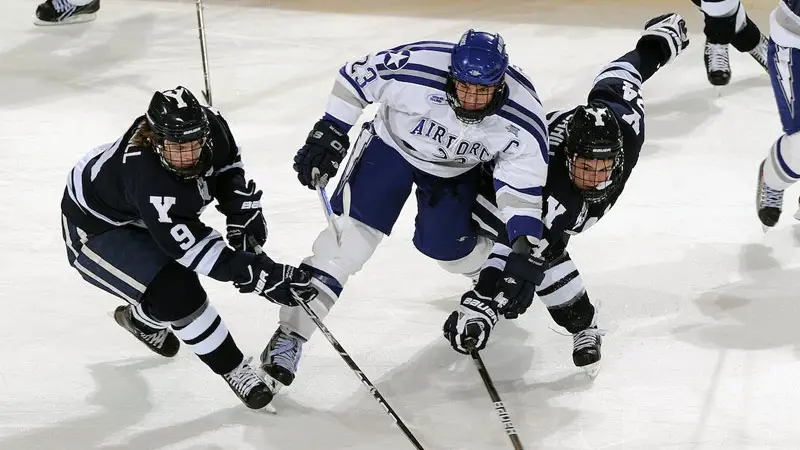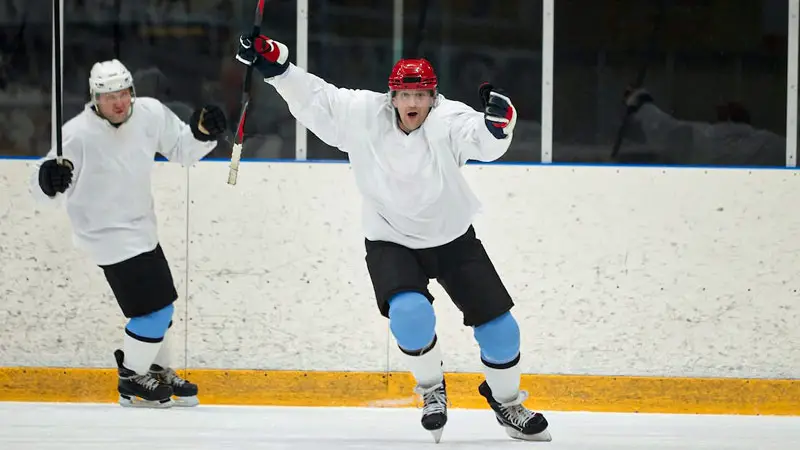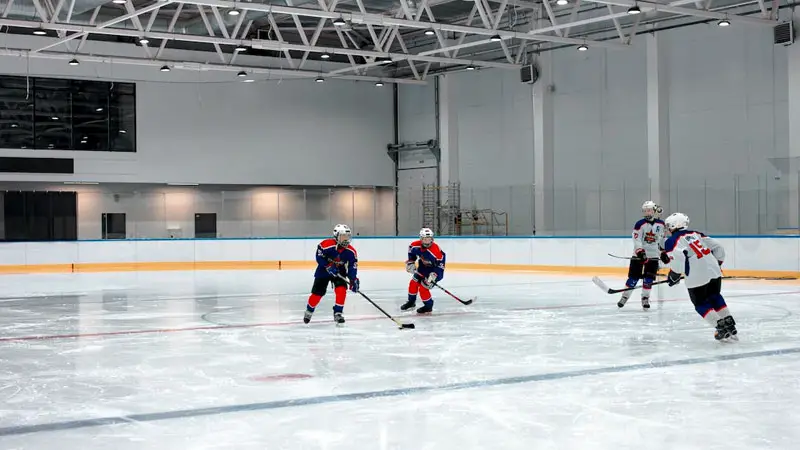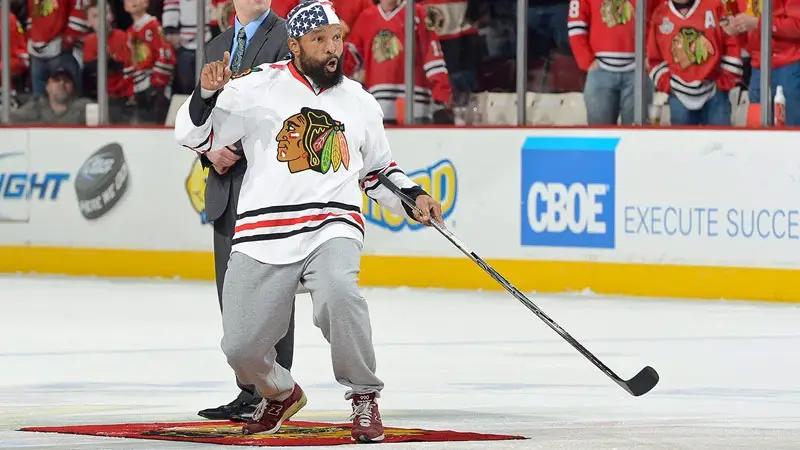A center in hockey is the linchpin of a team, a pivotal player bridging offensive and defensive responsibilities on the ice.
Positioned at the heart of the action, the center is not confined to scoring goals alone; instead, they orchestrate the ebb and flow of the game.
In essence, a hockey center is a multifaceted athlete, embodying the quintessential two-way player. Primarily recognized for their prowess in faceoffs, centers dictate possession from the onset, influencing the game’s tempo.
As playmakers, they showcase exceptional vision, creating scoring opportunities through precise passes and strategic positioning.
Moreover, centers are indispensable in defensive roles, clogging passing lanes, intercepting plays, and contributing to overall team stability.
This comprehensive skill set defines the center’s significance, making them instrumental in shaping the dynamics of a hockey match, where their impact extends far beyond the goals they score.
The Basics of the Center Position in Hockey
The center position in hockey holds a pivotal role on the ice, acting as a linchpin between offense and defense.
Often considered a linchpin in team strategy, centers are not only tasked with contributing to offensive plays but also play a crucial role in maintaining defensive stability.
Beyond their skill in scoring goals and creating offensive opportunities, centers are required to exhibit a well-rounded set of attributes that contribute to the overall success of the team.
Criteria for an Effective Center:
Faceoff Prowess
Centers need to excel in faceoffs, as winning possession of the puck right from the start is crucial for gaining a strategic advantage.
Skating Ability
Agile and swift, centers must be adept skaters to navigate the fast-paced nature of the game, enabling them to transition seamlessly between offensive and defensive responsibilities.
Playmaking Skills
A keen understanding of the game and excellent vision on the ice is essential for centers to make accurate passes and set up scoring opportunities for their teammates.
Defensive Awareness
While often recognized for offensive contributions, centers must also possess a strong defensive mindset. Awareness of opponents’ movements and the ability to disrupt opposing plays are vital defensive skills.
Physical Presence
Centers should be physically resilient and capable of holding their ground, particularly in front of the net. This physical presence aids in both offensive and defensive situations.
Versatility
Versatility is a key trait for centers, as they need to adapt to various situations during a game. This includes transitioning between power plays, penalty kills, and even-strength situations seamlessly.
Faceoff to Backcheck Transition
Quick transitions from winning a faceoff to participating in the defensive backcheck are crucial. Centers must be able to read the flow of the game and respond swiftly to changes in possession.
Hockey IQ
High hockey intelligence is indispensable for centers. Understanding the ebb and flow of the game, recognizing opponent strategies, and making split-second decisions are all part of the mental acumen required for success in this position.
These criteria collectively define the skill set needed for a center to excel in the fast-paced and dynamic environment of hockey, contributing not only to offensive prowess but also to the team’s overall defensive stability.
Offensive Role of the Center

The offensive role of the center in hockey is central to the team’s goal-scoring efforts and overall offensive strategy. Centers play a pivotal role in creating scoring opportunities, facilitating puck movement, and contributing to the team’s offensive success.
Here are key aspects of the offensive responsibilities of a center:
Playmaking and Passing
Centers are often playmakers, responsible for setting up scoring chances by delivering precise and well-timed passes to teammates. Their vision on the ice allows them to identify open teammates and exploit defensive gaps.
Faceoff Advantage
Winning faceoffs is a critical offensive skill for centers. Gaining possession of the puck immediately from a faceoff provides the team with a valuable opportunity to launch an offensive attack and control the pace of the game.
Scoring Goals
While wingers are often associated with goal-scoring, centers are expected to contribute goals as well.
Whether through accurate shots, deflections, or rebounds, centers need to capitalize on scoring chances to add to the team’s offensive output.
Net-front Presence
Centers often position themselves in front of the opposing team’s net, screening the goaltender, and looking for deflections or rebounds. This net-front presence is crucial for creating chaos in the opposing team’s defensive zone.
Cycle Play
Centers play a key role in the cycle game, maintaining possession of the puck along the boards and creating space for their linemates. This sustained offensive pressure can wear down the opposing team and lead to scoring opportunities.
Power Play Contribution
Centers are frequently featured on power play units, utilizing their playmaking skills and offensive awareness to exploit the opponent’s penalty kill.
They may quarterback the power play from the half-boards or set up in front of the net for deflections and rebounds.
Backchecking to Offensive Transition
After participating in defensive responsibilities, centers play a crucial role in transitioning from the defensive zone to the offensive attack.
Their ability to quickly join the rush and support the attack is essential for maintaining offensive pressure.
Hockey Sense and Decision Making:
Centers must possess a high level of hockey intelligence, making smart decisions in real time. This includes knowing when to shoot, pass, or hold onto the puck to create the best scoring opportunities for the team.
In summary, the offensive role of the center is multi-faceted, requiring a combination of playmaking, goal-scoring, and strategic positioning.
Centers are not only responsible for putting points on the board but also for orchestrating the team’s offensive flow and creating a dynamic, effective attack.
Defensive Responsibilities of Center in Hockey

The defensive responsibilities of a center in hockey are critical for maintaining team stability and preventing the opposing team from scoring.
While centers are often recognized for their offensive contributions, their defensive duties are equally important.
Here are key aspects of the defensive responsibilities of a center:
Clogging the Middle
Centers play a crucial role in clogging the middle of the ice in the defensive zone.
By positioning themselves strategically, they make it difficult for opponents to navigate through the center of the ice and create high-quality scoring chances.
Intercepting Passes
Centers need to anticipate and intercept passes from opponents, disrupting the flow of the opposing team’s offensive plays. This involves reading the play, positioning themselves in passing lanes, and using their stick to break up passes.
Backchecking
After losing possession or during defensive transitions, centers are responsible for quickly backchecking to support the defense.
This involves skating hard back to the defensive zone to provide additional coverage and limit the opponent’s offensive opportunities.
Defensive Zone Coverage
Centers must be aware of their defensive zone coverage responsibilities. This includes marking opposing players, tying up sticks in front of the net, and supporting defensemen in maintaining defensive structure.
Blocking Shots
Centers are expected to contribute to shot-blocking efforts, sacrificing their body to prevent shots from reaching the goaltender.
This commitment to shot blocking is crucial for disrupting the opponent’s offensive plays and protecting the net.
Faceoff to Defensive Transition
Centers need to seamlessly transition from faceoffs to defensive responsibilities.
Winning a faceoff is just the beginning; they must then be prepared to defend against immediate offensive pressure and ensure the team is well-positioned defensively.
Neutral Zone Presence
Centers play a role in defending the neutral zone, disrupting opposing players’ progress, and preventing smooth entries into the offensive zone. This involves applying pressure to opponents carrying the puck through the neutral zone.
Penalty Killing
Many centers are key contributors to penalty-killing units. During penalty kill situations, centers must excel in defensive zone coverage, shot-blocking, and clearing the puck to minimize the opponent’s power play effectiveness.
Communication
Effective communication is vital for centers on the defensive end. They must coordinate with defensemen, wingers, and the goaltender to ensure everyone is aware of their assignments and responsibilities in different defensive situations.
The defensive responsibilities of a center extend beyond merely preventing goals; they are integral to the team’s overall defensive structure and success.
A well-rounded center excels in both offensive and defensive aspects of the game, contributing to the team’s overall performance on the ice.
Essential Skills for Centers in Hockey

Mastering faceoffs is a fundamental skill for centers. The ability to consistently win faceoffs provides a team with crucial possession, dictating the flow of the game.
Centers need precise timing, strength, and a variety of faceoff techniques to excel in this critical aspect of play.
Exceptional Skating Ability
Centers must be agile and possess excellent skating skills. Quick lateral movement, acceleration, and the ability to change directions rapidly are essential for navigating the fast-paced nature of the game.
Superior skating allows centers to both create offensive opportunities and contribute defensively.
Playmaking and Passing Skills
A center’s playmaking ability is paramount. Vision, creativity, and accurate passing are vital for setting up scoring chances.
Centers need to read the game, anticipate movements, and deliver precise passes to teammates to orchestrate effective offensive plays.
Defensive Awareness
Defensive acumen is a hallmark of a well-rounded center. Understanding defensive responsibilities, positioning, and reading the opponent’s plays contribute to effective backchecking, intercepting passes, and overall defensive stability.
A center’s defensive awareness complements their offensive skills, making them a two-way threat.
Net-front Presence
Centers should excel in establishing a presence in front of the opposing team’s net.
Whether screening the goaltender, deflecting shots, or capitalizing on rebounds, a center’s ability to create havoc in the crease contributes significantly to goal-scoring opportunities.
Versatility
Versatility is a key asset for centers. They must seamlessly transition between offensive and defensive roles, adapt to various game situations, and contribute to power plays, penalty kills, and even-strength situations.
A versatile center enhances the team’s overall flexibility and effectiveness.
Hockey IQ
High hockey intelligence is essential. Centers need to read the flow of the game, make split-second decisions, and understand the strategic nuances of each situation.
This includes recognizing when to exploit offensive opportunities, identifying defensive gaps, and adapting to the dynamic nature of the game.
Physical Resilience
Centers often engage in physical battles in front of the net and along the boards.
Physical resilience, strength on the puck, and the ability to withstand checks are crucial for maintaining possession and excelling in both offensive and defensive scenarios.
A physically resilient center contributes to the team’s overall competitiveness.
Centers in hockey must possess a well-rounded skill set that encompasses faceoff proficiency, exceptional skating, playmaking prowess, defensive awareness, net-front presence, versatility, hockey intelligence, and physical resilience.
Mastery of these skills allows centers to make significant contributions to both offensive and defensive aspects of the game, making them invaluable assets to their teams.
Transition Play and Two-Way Game For Hockey Centers
Transition play and a strong two-way game are integral aspects of a hockey center’s skill set, allowing them to effectively contribute to both offensive and defensive situations. Here’s an exploration of these concepts:
Transition Play
- Quick Transition from Defense to Offense: Centers play a key role in rapidly transitioning from defensive responsibilities to initiating offensive plays. This involves quickly moving the puck out of the defensive zone, making smart passes, and joining the rush to create scoring opportunities.
- Neutral Zone Prowess: A skilled center excels in navigating the neutral zone during transitions. This includes smoothly carrying the puck, making precise passes, and effectively entering the offensive zone to maintain momentum and catch opponents off guard.
- Speed and Acceleration: Centers need explosive speed and acceleration to capitalize on transition opportunities. Rapid acceleration allows them to break away from defenders and create odd-man rushes, putting pressure on the opposing team’s defense.
- Supporting the Defense: During defensive transitions, centers provide support to the defensemen by backchecking and ensuring a smooth exit from the defensive zone. This support helps the team regain possession and transition into offensive play more efficiently.
Two-Way Game
- Backchecking and Defensive Responsibility: A strong two-way center is committed to backchecking with intensity. This involves tracking back quickly to disrupt opposing offensive plays, helping out in the defensive zone, and preventing the opponent from gaining easy access to scoring areas.
- Defensive Zone Coverage: Centers must exhibit strong defensive zone coverage. This includes marking opponents, blocking passing lanes, and supporting defensemen in maintaining a structured defensive presence. Solid defensive zone coverage contributes to overall team defense and helps prevent goals against.
- Reading the Play: Centers with a strong two-way game possess the ability to read the flow of the game effectively. This includes anticipating opponents’ movements, recognizing defensive vulnerabilities, and making split-second decisions that contribute to both offensive and defensive success.
- Faceoff to Defensive Transition: Transitioning seamlessly from winning a faceoff to fulfilling defensive responsibilities is crucial. Centers need to be mentally agile, instantly shifting their focus from offensive opportunities to defensive duties to ensure the team is well-positioned to counter opponents.
- Penalty Killing: Many two-way centers play significant roles in penalty-killing units. Their defensive awareness, shot-blocking ability, and faceoff skills make them valuable assets during shorthanded situations, contributing to the team’s overall defensive prowess.
- Balancing Offensive and Defensive Contributions: A successful two-way center strikes a balance between offensive creativity and defensive responsibility. They understand when to join the attack and when to prioritize defensive duties, providing a stabilizing influence that enhances the team’s overall performance.
Transition play and a strong two-way game are essential for hockey centers. Excelling in these areas allows centers to seamlessly contribute to both offensive and defensive aspects of the game, making them versatile and impactful players on the ice.
FAQs
How important are faceoff skills for a center?
Faceoff skills are crucial for a center. Winning faceoffs provides immediate puck possession, influencing the game’s momentum.
Centers use techniques like timing, strength, and strategy to gain an advantage and contribute significantly to team success.
Can a center focus solely on offense, or is defense equally important?
While centers are known for offensive contributions, a complete player excels in both areas.
Centers play a vital role in defensive responsibilities, including backchecking, defensive zone coverage, and disrupting opponent plays, ensuring a well-rounded contribution to the team’s performance.
How does a center contribute to special teams, particularly the power play?
Centers often quarterback the power play, utilizing playmaking skills to create scoring chances. They set up plays from the half-boards, distribute passes, and contribute to net-front presence.
Their ability to read the game and make quick decisions enhances power play effectiveness.
What skills make a successful two-way center in hockey?
A successful two-way center excels in faceoffs, possesses exceptional skating ability, demonstrates defensive awareness, and contributes to both offensive and defensive transitions.
Wrapping Up
In hockey, the center position is a linchpin, embodying versatility by seamlessly blending offensive prowess with defensive responsibility.
Masters of faceoffs, skilled playmakers, and defenders, centers play a pivotal role in dictating the game’s flow.
Their contribution extends beyond scoring goals, encompassing strategic play, transition dynamics, and a commitment to both ends of the rink.
A complete center epitomizes the essence of a two-way player, navigating the ice with finesse, making critical decisions, and embodying the spirit of teamwork.








James Felix